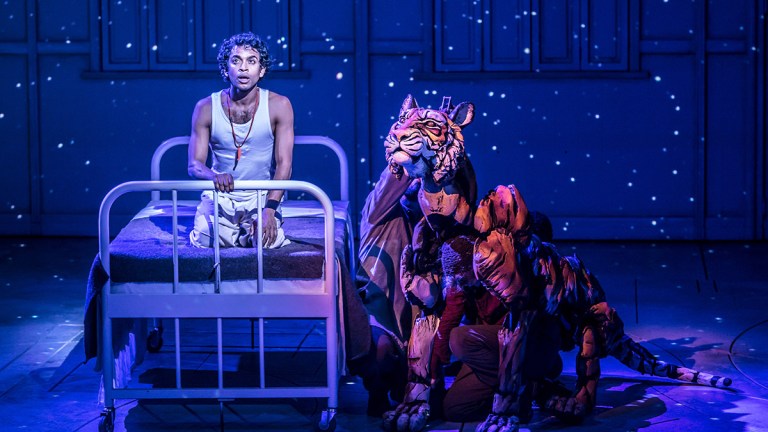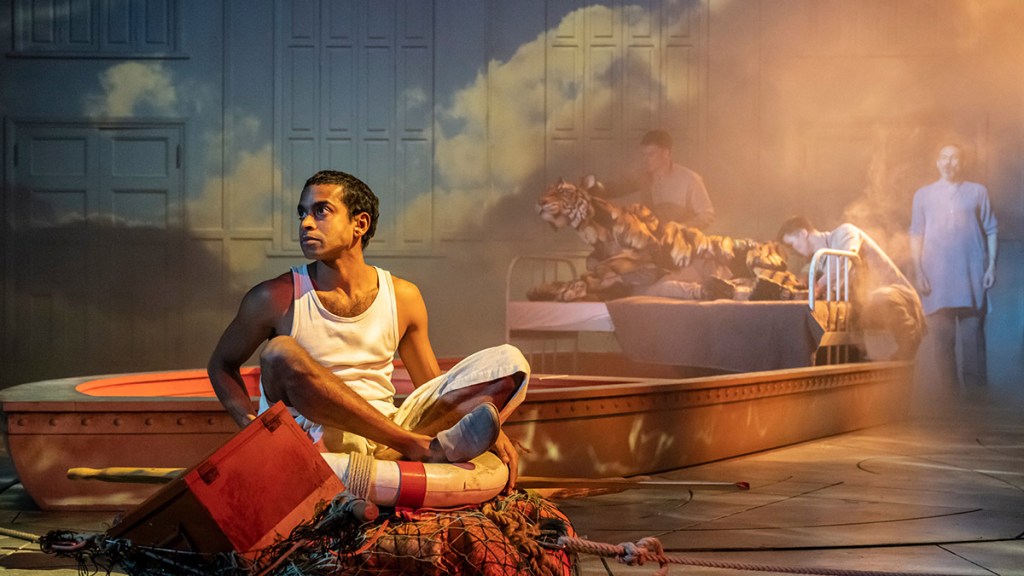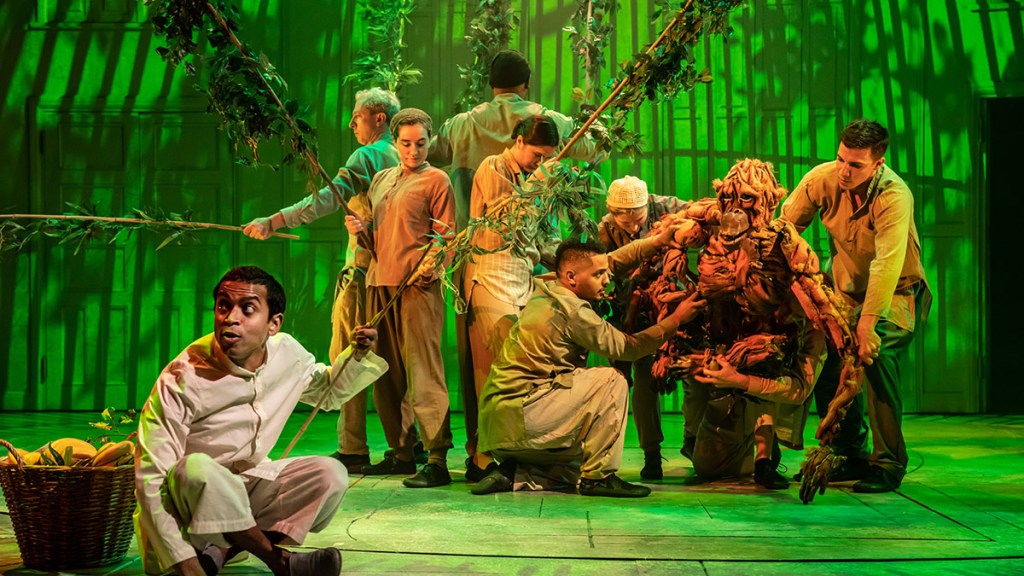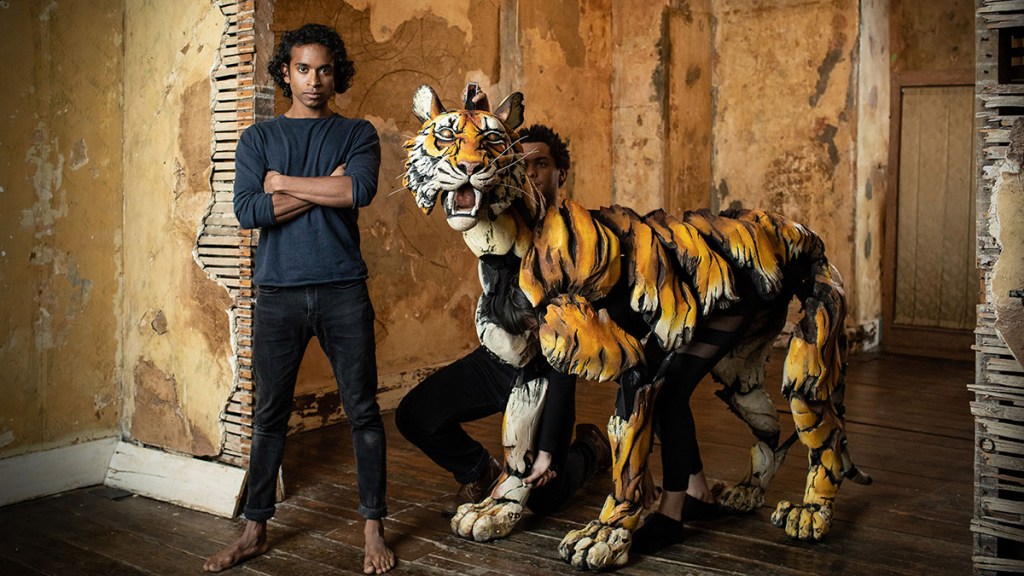Life of Pi: Inside the West End Phenomenon
Director Max Williams talks a tiger, a boat, and a sea all existing on a West End stage via the new West End play.

Want to win tickets to see Life of Pi? Enter our giveaway!
Yann Martel’s best-selling 2001 novel, Life of Pi, was first adapted by director Ang Lee and writer David Magee into an award-winning film in 2012. Ten years later, writer Lolita Chakrabarti and director Max Webster have adapted it into a stage play that’s won five Olivier awards, including Best New Play and Best Set Design.
Life of Pi tells the marvellous story of Pi Patel, a boy from Pondicherry, India named after a French swimming pool who was raised in a zoo. He boards a Japanese cargo ship headed to Canada with his family and all of their animals, only to end up stranded at sea for 227 days on a lifeboat with an adult Bengal tiger named Richard Parker.
The stage adaptation takes audiences from Mexico to India, to Manila, and through a carnivorous island somewhere in the Pacific in a stunning flurry of design and puppeteering. We talked with director Max Webster about how the journey from page to stage panned out.
When describing your directing style, you say that you like to find the playful and the magical. I find that really fascinating in relation to several aspects of Life of Pi. What was the thing that took the most magic in staging this adaptation?
I like staging the impossible. It’s a nice thing to try and do. It’s partially a challenge. How high can you jump? There’s something brilliant about doing that. I think I also really believe in non-literal theater. There’s a lot of less exciting theater that’s made that is incredibly literal. I like more imaginative stuff or poetic stuff. And I think that hyperrealism is better done on Netflix than it is in a theater. You want something that’s a bit more poetic on stage. In theater you can do a horse race on a one meter-square bit of stage. You can basically tell any story in any format on stage.
I think there is also something political in trying to believe the unbelievable. The impossible can be staged. It’s like if you could really sit and imagine something that you think you can’t really imagine. I think that has a meaning for me. It is really meaningful when an audience can come out of a show and say, “Wow, I didn’t know that was possible before.”
What if we could imagine a tiger in a boat, in the sea, in a little theater? Well, then maybe we could imagine a fair society, equality, and equity too.

You’re no stranger to solving sticky situations on stage. You directed Suranne Jones through 400 years of history in a few hours in Orlando, for instance. Were there any particularly unique challenges in staging Life of Pi?
Oh gosh, what was hard about Life of Pi? People think, how do you do the tiger? How do you do the different cities?
What was really difficult was touring different departments and trying to bring it all together with so many moving parts. They were easier parts though. I think the harder thing was to try and find a backbone or a story in Yann’s novel that could translate to stage. He talks about his book as an image rather than a story. There’s a boy and a tiger on a boat. That is the central picture, but then the amount of story around it is quite minimal.
A family is migrating, there is a shipwreck, and then there is Pi with Richard Parker on this little boat. So working together with the entire team to tell the story and use that core image to get to what you see on stage. That was the difficult part.
Speaking of the adaptation, Lolita said in an early interview that when you were at the Crucible in Sheffield, the show was three hours long. The run time at the Wyndham is only just about two hours, relatively short for a West End production. Does this mean that the script evolved a lot between the first staging and now?
Yes. Lolita rewrote little bits every day all the way through Sheffield. The printers were definitely moving fast at that stage.
How did the actors feel about that?
They were amazing. Hiran [Abeysekera]who has played Pi both at the Crucible and the Wyndham would accept the rewrite and learn it in five minutes, then go and do it off book. Since it was him getting 90 percent of the rewrites, and he took them in such good graces, I think the rest of the cast found it very hard to complain.
Speaking of the transfer, how has the experience of the show changed for you between Sheffield and London?
That’s interesting. Obviously, you’ll have had to rehearse it for the new space. The Crucible’s a really special space in that it’s very democratic. Everyone has a similar experience of the show regardless of what tickets they’ve bought. Whereas I think in the Wyndham you get quite different experiences, different levels.
In the stalls you are really immersed in things, in the circles you are looking down and seeing the patterns, and the videos and so on. Up in the gods is kind of thrilling because you see all the shapes and things moving around. Sheffield and London audiences also do sound a bit different, but they’ve been great in both.

A lot of the actors are playing multiple roles in the production. Were the decisions about who doubled up—and the meanings that might be taken from those doublings—discussed fairly early in the process?
Yes, because it was cast early. We worked out a lot of the role doubling during the first draft and stuck with that. The more complicated thing to work out was how the puppeteers tracked through the show, where we had the speaking actors versus where the physical theater was. It was a game of moving targets for a bit.
Some of the doubling choices, like Syreeta Kumar playing the Mrs. Biology and Muslim woman, Zaida Khan, and Tom Espiner playing Catholic Father Martin and Commander Grant Jones, were really subtly effective in representing the colonial migrant and refugee experience articulated in the story. Were these choices intentional ones you and Lolita made for the stage?
We have hundreds of conversations about what things in this show mean. People come out saying, “That was a story about the migrant experience.” “That was a story about family.” “That was a story about love.” “That was a story about biology and tigers.” They have all seen the same thing and all come out with a very different sense of what it was about. I think that is the great thing about Life of Pi.
Yann has created this story that is metaphorically open enough for people to project onto it what they need to. I think of course it is really important to all of us that it is an international story. We live in an international city. We always have done. Anyone who says otherwise is in denial of history. It’s just that the way it is, international has changed and is always changing, but it is our history. So yes, I think that is a very important part of the story, but each time I speak to someone they have new interpretation
Did your background studying in Europe and directing opera help you grapple with some of those large themes: love, family, migration, politics?
I remember when I was an undergraduate, I said “themes” to my tutor. He looks at me, very snobbish, he looks at me and says, “One does not make poetry with themes, one makes poetry with words!” So, I think yes, of course these are huge themes, but you really direct with actions.
One of the things Lolita has done really beautifully is write those themes around all of the central images in the story. I really do hope that you sense those things are under discussion, but you don’t feel like you’ve sat down and watched a show about immigration, religion, migration, or anything like that. I hope it feels bouncy enough and gentle enough to really speak of what lies beneath it.
Pi does most of the speaking in the play. Was framing his story around the hospital inquisition something that you came up with to help break up the potential monologuing?
The first thought Lolita had was that the hospital inquisition, which in the novel only turns up in the final 30 pages, should be the overarching space for the evening. And I think what I didn’t realize about that choice at first is that it allowed us to mix the factual and naturalistic passages of the story with the more theatrically rich ones. One of the big challenges, for example, was “who is Pi talking to when he is on the boat?” With Lolita’s framing, you’ve got a series of different people and different flashbacks.
Many of the people Pi ends up talking to in the stage show are women. This isn’t true of the novel. Was this something you wanted to change from the start?
Yes, giving the women more to do than in the novel was something we consciously set out to do. In the novel Pi has a brother, not a sister. The teacher is a man, not a woman. So, there are a few easy, but important, gender flips. We wanted to give inspiration, charisma, agency, and power to women in this story.

Obviously, all the actors playing Richard Parker the Bengal tiger, made history with their joint Olivier win. To prepare them to play the animals, did you take any trips to see some animals up close and personal?
Yeah, actually! When we were in Sheffield, there was a trip to the zoo at some point. And there was certainly, at the beginning of the process, a lot of really careful animal watching. There was a lot of YouTube stalking.
We watched a zebra being eaten. That is when we realized that sometimes you try to be correct, but sometimes you have to be more imaginative. Turns out that when a zebra is being eaten, it goes totally still. If you have a puppet zebra and the puppet hyena starts eating its tummy on stage and it doesn’t respond, it looks like bad acting. So there were a few things we did have to change about the animal behaviors.
I think Yann was really helpful about the animals. He kept on saying to us that the animals are not cute, and this is not a Disney story. The point is that they’re real. The point of the entire story is that it’s at the border, the boundary of possibility. Everything in the story is actually possible. The days, times, measurements are precise. The number of days Pi’s alive is exactly the right amount he could be. It is the most improbable, but never impossible story.
Before we go, I have to ask, which of Pi’s stories do you believe?
I believe the story with the animals. Actually, what I really believe, I really believe that it’s possible for both. I think that is what I would want to try and say to people. I personally don’t think that one is true, and one is false.
I think that there are different possible ways of looking at the world. You can look at the world scientifically and so-called objectively. You can look at the world through religion or what Yann calls “magical thinking.” I would argue these are all different ways of describing the same thing.
The truth of one story doesn’t displace the truth of another.
Roaringly good seats at great prices for the Olivier Award winning, critically acclaimed smash-hit are on sale now. Don’t miss out, book now!